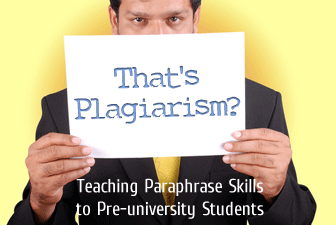That’s Plagiarism?: Teaching Paraphrase Skills to Pre-university Students


As educators and students, we hear the term plagiarism often, and guaranteed to come along with any mention of plagiarism is a warning against it. In some schools, expulsion can be the result of being caught plagiarizing. In an age where plagiarism carries such drastic consequences, taking organized and well documented notes becomes increasingly important. When you take time up front to document your ideas and support, it may save you a tremulous situation in the future. This is especially important for ESL students because the concept of intellectual property is not the same in every culture, and what may be perfectly acceptable in a student’s native culture can be very inappropriate in their host country.
Make sure your students understand that plagiarism is taking another person’s words and presenting them as your own. In addition, plagiarism is taking another person’s ideas and presenting them as your own. The second trap of plagiarism is far easier to fall into. Therefore, each note your students take should include the name of the author and the source from which the note came, the location in the source (page number or location on web site as best as can be explained) as well as the type of note that it is. Following is an explanation of the different types of notes.
Direct Quotation
When researching, a direct quotation is the easiest type of note to take and the one with the least value. Your students should aim to limit direct quotations to no more than 10% of their total notes. A direct quote copies the author’s exact words from a source. A direct quotation should only be recorded when the exact wording of the author has specific value. These should be written with quotation marks on either side. Use ellipses (…) to show omitted portions and brackets [ ] to show any words that have been added or changed.
Paraphrase
A paraphrase is more useful than a direct quotation because the researcher has already written the idea in his or her own words. In a paraphrase, the researcher writes the same information that the author gives but in his or her own words. The length of a paraphrase should be similar to that of the original. Encourage your students to aim for about thirty percent of their notes as paraphrases. When using a paraphrase in a research paper, your students should still cite the source from which the note was taken.
Summary
Most ESL students have experience writing summaries. A summary takes a large amount of information from a source and condenses it using unique wording. A summary note will be much shorter than the original source. These notes are useful for remembering large amounts of information. Your students should keep summaries at around thirty percent of their total note taking.
Personal Thoughts
The final and most useful type of note is the personal thought. Part of research is developing original opinions and thoughts about your topic. Though we believe that we will remember our own thoughts when the time comes to write, the truth of the matter is that we will forget our original ideas more than we will remember them. Consequently it is essential that we write down our own ideas as they come to us during research. These thoughts might be opinions on something we have read, suggestions for further research or any of many other thoughts. If students are encouraged to note their own ideas as well as those of the authors they are reading, they will put more value on their own thoughts and opinions. That, after all, is the point of doing research: not to feed back a collection of information but to synthesize and apply the information we are learning. Personal thoughts are most useful when writing a research paper because they can be used in their entirety without fear of plagiarism. Students should aim to include at least twenty percent of their research notes as personal thoughts.
If you stress the importance of well documented note taking to your students and warn them of the serious consequences of plagiarism, they will have a firm foundation for doing research in a forthright and upfront matter.